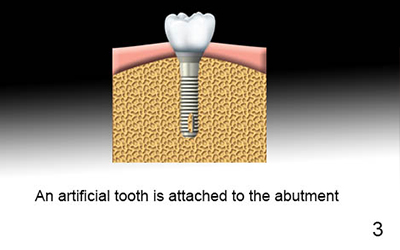Dental Implants
Implants are an alternative to dentures or bridgework, but they are more expensive. Implants are titanium rods, which are surgically placed into the jawbone and act as anchors for fastening dentures or crowns onto.
If you are in good general health, have healthy gums and have enough bone in the jaw to hold an implant, dental implants might be right for you. If your jawbone has shrunk or if it has not developed normally, you may be able to have a bone graft to build up the bone. A bone graft is a way of adding new bone to your jawbone.
Dental Implants Procedure:
- Our dentist will carefully examine your mouth and take x-rays of your head, jaw and teeth to find out if dental implants are right for you.
During the first stage of surgery, we will put a dental implant into your jawbone beneath the gum tissue. The gum tissue is then stitched back into place. As the tissue heals, the implant will bond with the bone and attach to the gum. It can take several months to heal. - During the second stage of surgery and once the tissue is healed, we will attach an abutment to the implant. An abutment is a post that connects the replacement tooth to the implant. In some cases, the first and second stage of implant surgery may be done in one single stage.
- An artificial replacement tooth is made and we attaches it to the abutment. It may take several appointments to properly fit the replacement tooth to the abutment.
- When replacing several teeth or all of your teeth, a fixed bridge is anchored to your dental implants. A bridge is a dental restoration that replaces one or more missing teeth by spanning an area that has no teeth. The bridge is held firmly in place by dental implants on each side of the missing tooth or teeth.










